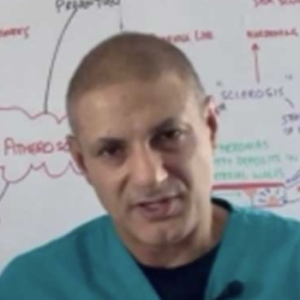Low-dose naltrexone (LDN) has quickly become one of the most talked-about treatments for a wide range of chronic health challenges, from autoimmune diseases and persistent pain to gut issues and even mental health. But how can such a tiny dose of a medicine designed initially for addiction have such broad effects? In this guide, we’ll break down the science, explain the jargon, and show you why LDN is so intriguing for patients and healthcare professionals alike.
A friendly, science-backed guide to how low-dose naltrexone helps your body and brain.
Table of contents
- A friendly, science-backed guide to how low-dose naltrexone helps your body and brain .
- Key Takeaways
- Who is this article for?
- What is Low-Dose Naltrexone (LDN)?
- Dr. Bernard Bihari, the pioneer of LDN
- The link between endorphins and the immune system
- The role of beta-endorphins in inflammation and immunity
- How low-dose naltrexone (LDN) boosts endorphins and helps the immune system
- How LDN boosts endorphins
- Enkephalins: Your body’s other natural painkillers
- How are enkephalins different from endorphins?
- Summary Table: Enkephalins vs Endorphins
- How does LDN influence the endorphin and enkephalin levels in the body?
- Finding the correct dose of naltrexone
- The role of endorphins and opioid receptors
- Opioid receptors
- The zeta opioid receptor or Opioid Growth Factor Receptor (OGFr)
- Summary of Ian Zagon’s study on the role of opioid growth factor in cancer
- More science: How does LDN work in the body?
- How does low-dose naltrexone (LDN) reduce inflammation?
- Summary: How does low-dose naltrexone (LDN) work?
- Tips for using LDN
- LDN FAQs
- Courier Pharmacy is your trusted specialist for Low Dose Naltrexone (LDN) compounding.
- Why choose Courier Pharmacy for your LDN?
- References
Key Takeaways
- LDN works by gently modulating both your immune and nervous systems, not just blocking opioid receptors.
- At low doses, it acts on glial cells and toll-like receptors, dialling down inflammation in the brain and body.
- LDN briefly blocks opioid receptors, prompting the body to make more natural painkillers like endorphins.
- Its unique “chirality” means different molecular shapes target different pathways, giving LDN its broad effects.
- LDN is being researched for conditions like multiple sclerosis, Crohn’s, fibromyalgia, cancer and more, but it’s not a magic bullet—always talk to a healthcare professional first.
Who is this article for?
This guide is for anyone curious about new ways to manage chronic health conditions, patients considering LDN, and healthcare professionals seeking a clear and honest look at the science. We’ll keep it friendly, practical, and easy to follow—no PhD required.
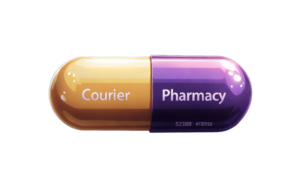
What is Low-Dose Naltrexone (LDN)?
Naltrexone was first developed in the 1960s and licensed in the 1980s as a treatment for opioid and alcohol addiction, usually at high doses (50mg or more) [1], [2]. At these doses, it blocks opioid receptors in the brain, stopping the effects of drugs like heroin and reducing cravings for alcohol [2].
Naltrexone also blocks natural chemicals called endorphins, which are produced by the brain and help regulate pain, mood, and the immune system [3].
In the early 1980s, researchers Dr. Patricia McLaughlin and Dr. Ian Zagon at Penn State began investigating the effects of administering small doses of naltrexone to animals, and they discovered that it could slow down tumour growth [4].

Dr. Bernard Bihari, the pioneer of LDN
Then, in 1985, Dr. Bernard Bihari, a New York City physician, discovered that taking a low dose of naltrexone (around 3mg at bedtime) could positively influence the immune system. He initially observed that this approach helped improve immune response in patients with HIV/AIDS, later determining that 3mg was the optimal adult dose [3].
By the mid-1990s, Dr. Bihari also noted that low-dose naltrexone (LDN) sometimes produced significant benefits for patients with certain cancers (like lymphoma and pancreatic cancer) and provided rapid relief for those with autoimmune conditions such as lupus [3].
More and more doctors began prescribing naltrexone at low doses and found these small doses appeared to have a totally different effect, especially on the immune system and inflammation [5].
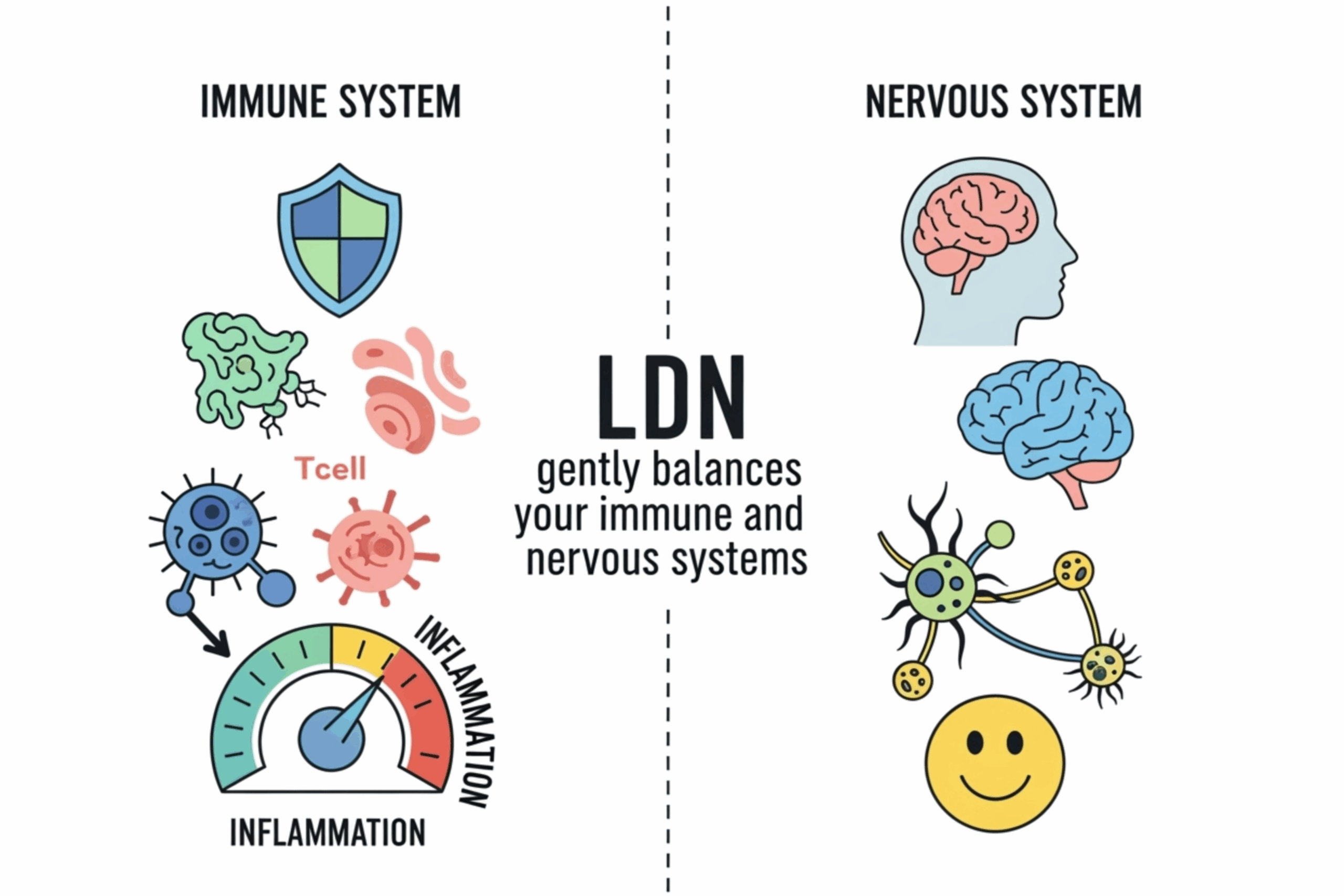
The link between endorphins and the immune system
Before we delve into the details of how LDN works, we need to take a brief detour to understand how our natural painkillers, the endorphins, are connected to the immune system.
Research in the 1980s discovered that our natural painkillers, the endorphins, could modulate the immune system [6].
Your immune and hormone systems “talk” to each other. When you get an infection or a vaccine, your immune cells can produce hormones like ACTH and endorphins—typically produced by the brain—to help the body respond [6]. These hormones can also send calming signals back to the immune system.
Therefore, both systems utilise the same messengers to help the body cope with stress and illness.

Immune cells can make endogenous opioids
Your immune system can actually help reduce pain by making and releasing its own natural painkillers (called opioid peptides, like endorphins and enkephalins) [7].
Different types of immune cells—both from the “innate” part (like macrophages and neutrophils, which are your body’s first responders) and the “adaptive” part (like T-cells, which remember and fight specific germs)—can produce these pain-relieving chemicals [7], [8].
Some immune cells in our body, such as blood cells and white blood cells, have instructions, or mRNA, that help them produce natural painkillers, including beta-endorphin and enkephalins.

Why immunosuppressants can increase pain sensitivity
When certain medications weaken the immune system, individuals may experience increased sensitivity to pain from conditions such as heat or pressure, especially if they already have underlying inflammation. This indicates that immune cells—and the mRNA instructions within them—play a crucial role in enabling our bodies to manage pain effectively [9].
When inflammation or injury occurs, these immune cells release opioid peptides at the site, which then bind to specialised pain-relief receptors on nerve cells. This helps block pain signals, making you feel less pain.

The role of beta-endorphins in inflammation and immunity
When inflammation occurs in the body, immune cells are drawn to the affected area. These immune cells can produce beta-endorphins, which act like natural painkillers and have anti-inflammatory effects.
Beta-endorphins help calm inflammation by boosting “good” anti-inflammatory signals (such as IL-10 and IFN-gamma) and reducing “bad” pro-inflammatory signals (like IL-1, IL-6, and TNF-alpha). This helps stop the chain reaction that causes swelling and tissue damage [10].

The role of beta-endorphins in cancer
Beta-endorphins also play a role in protecting against cancer. They can block certain processes (like NF-KB activity) that help tumours grow and spread.
They support the body’s natural defences by keeping important genes (like P53) working properly, and help cells stick together to prevent cancer from spreading [10].

Immune cells have opioid receptors
Most immune cells—like neutrophils, T-cells, B-cells, macrophages, and others—have special receptors that can “catch” beta-endorphins [11].
When beta-endorphins bind to these receptors, they can “switch on” both the fast-acting (innate) and long-term (adaptive) parts of the immune system [11].
This can lead to more active natural killer cells, increased T-cell and B-cell activity, and the release of important chemicals and antibodies that help fight infections [11].

The role of beta-endorphins in immunity and the stress response
When the body is under stress due to inflammation, it releases a hormone called CRH, which signals endorphin-producing cells to produce more endorphins.
These endorphins then act locally on immune cells to fine-tune the immune response and help control inflammation.
The amount of beta-endorphins in the blood can originate from both the brain (specifically, the pituitary gland) and from immune cells themselves [11].

How low-dose naltrexone (LDN) boosts endorphins and helps the immune system
Dr. Bernard Bihari discovered that low-dose naltrexone (LDN) could help people with HIV/AIDS, cancer, and autoimmune diseases by “resetting” the immune system. Here’s how it works and why it matters:

How LDN boosts endorphins
When you take a low dose of naltrexone (about 3mg) at bedtime, it briefly blocks your body’s opioid receptors for a few hours while you sleep [3].
The brain, especially a part called the hypothalamus, senses this block and thinks there aren’t enough endorphins—your body’s natural “feel-good” and immune-supporting chemicals [3].
To fix this, the hypothalamus produces more of a special protein called pro-opiomelanocortin (POMC).
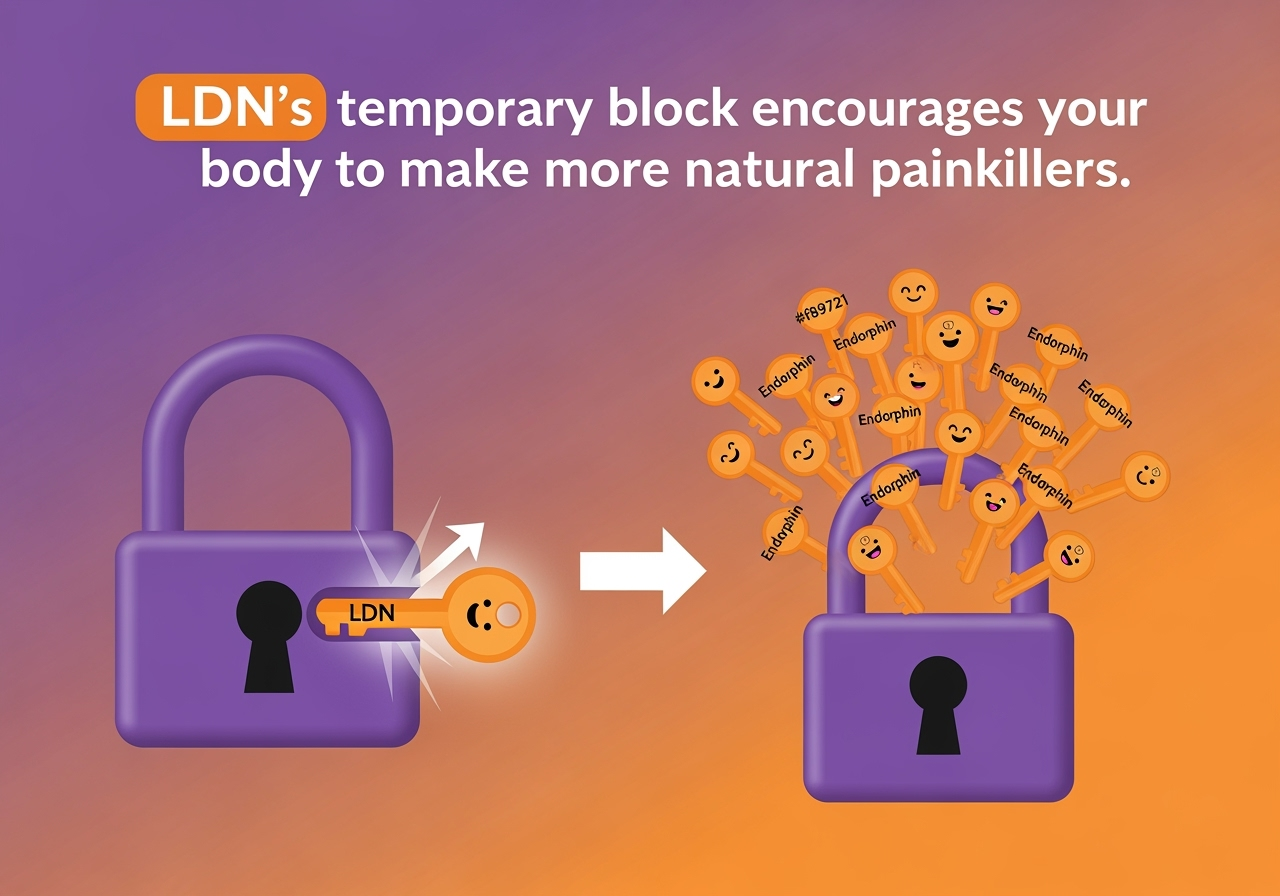
POMC the building block for endorphins
Scientists first discovered the body’s natural painkillers, called endorphins, in the 1970s [12]. The name “endorphin” means “endogenous morphine,” which basically means morphine made inside our bodies.
Humans and animals make at least 20 different types of endorphins. Four main types are called alpha, beta, gamma, and sigma endorphins [11].
Most beta-endorphins are made and stored in a small gland at the base of the brain called the pituitary gland. They are produced from a larger protein called POMC [13]. Interestingly, some immune cells in the body can also produce beta-endorphins, especially during inflammation, because they possess the necessary genetic instructions (mRNA) to do so [11].
When we experience stress or pain, the brain sends a signal to the pituitary gland to start making more POMC. This large protein is then broken down into several helpful substances, not just beta-endorphin [11]. These include:
- Alpha-melanocyte-stimulating hormone (?-MSH): helps control skin colour and reduces inflammation.
- Adrenocorticotropic hormone (ACTH): tells the adrenal glands to make stress hormones like cortisol.
- Other peptides, which have various roles in the body.
If too many of these substances accumulate, the brain receives a signal to slow down production, helping to maintain balance.

When are endorphins made in the body?
So, we have learn that POMC is like a starter ingredient that gets split into several important hormones, including beta-endorphin [13]. This typically occurs mostly at night, when the body naturally produces the highest levels of endorphins.
The POMC travels to the pituitary gland, where it’s chopped up into smaller parts—one of which is beta-endorphin, a powerful natural painkiller and immune booster.

Enkephalins: Your body’s other natural painkillers
While endorphins often get the spotlight as the body’s “feel-good” chemicals, enkephalins are another important member of the same natural painkiller family [14].
What are enkephalins?
Like endorphins, enkephalins are part of the endogenous opioids group, meaning they’re made by your own body to help manage pain and stress[15].
Scientists first discovered enkephalins in 1975 [16]. There are two main types: one called leu-enkephalin (which contains the amino acid leucine) and the other called met-enkephalin (which contains methionine) [17]. Met-enkephalin is also known as the Opioid Growth Factor (OGF).
Both types are made from the same gene in your body. Enkephalins are made up of just five building blocks, called amino acids, and work by helping to block pain signals [17].

How do enkephalins work?
Enkephalins attach to special sites on nerve cells—called opioid receptors—found throughout your brain, spinal cord, and body. When they bind to these receptors, they block pain signals, helping you feel less pain [14]. They also play a role in controlling emotions, protecting nerve cells, and even regulating appetite and movement [14].

Where are enkephalins made?
Your body produces enkephalins in the brain, spinal cord, certain immune cells, and the adrenal glands [18], [19].

Why are enkephalins important for pain?
Enkephalins are released when your body needs to manage pain, such as after an injury or during inflammation. They help block pain signals before they reach your brain [14].

What else do enkephalins do?
Besides pain relief, enkephalins help:
- Regulate mood and stress, by affecting how your brain responds to pain and emotions [14].
- Protect nerve cells from damage in diseases like Alzheimer’s and Parkinson’s [14].
- Influence reward and pleasure, making things like eating and socialising enjoyable [14].
- Control gut function and inflammation [14].

Enkephalins and disease
Changes in enkephalin levels have been found in people with chronic pain, migraines, arthritis, multiple sclerosis, Crohn’s disease, and cancer [14].
Boosting enkephalins, or stopping them from being broken down, may help manage pain in these conditions. Some new drugs and therapies, such as low-dose naltrexone (LDN), work by helping the body produce more enkephalins.

Enkephalins and cancer
Enkephalins may help relieve cancer pain and could also slow tumour growth by supporting the immune system and blocking signals that help cancer spread [14]. Some early studies suggest that administering met-enkephalin to cancer patients may improve their quality of life and potentially extend their lifespan [20].

How are enkephalins different from endorphins?
Although both enkephalins and endorphins help with pain relief, they have some differences:
- Endorphins (like beta-endorphin) are larger, mostly made in the pituitary gland, and are well-known for creating that mood boost after exercise (the “runner’s high”).
- Enkephalins are smaller, more widely spread in the nervous system, and are especially good at stopping pain signals in the spinal cord.
Both types work by attaching to opioid receptors, but enkephalins mainly target delta (?) receptors, while endorphins prefer mu (?) receptors [15].

Summary Table: Enkephalins vs Endorphins
| Feature | Endorphins | Enkephalins |
| Size | Larger | Smaller |
| Main location | Pituitary gland, brain | Brain, spinal cord, and immune cells |
| Main receptor target | Mu opioid receptors | Delta, mu and zeta opioid receptors |
| Main effects | Pain relief, mood boost | Blocking pain, especially in the spinal cord |
| Connection to LDN | LDN boosts production | LDN boosts production |
| Possible cancer link | May support the immune system | It may help the immune system fight cancer cells |
How does LDN influence the endorphin and enkephalin levels in the body?
Hopefully, you can now appreciate the positive roles that the endorphins and enkephalins play in our health. The question is how to boost our levels? This is where LDN or low-dose naltrexone makes its grand entrance onto the stage.
We know that low-dose naltrexone (LDN) is a medication that, in small doses, briefly blocks opioid receptors.
This temporary block tricks the body into making more of its own pain-relieving chemicals, including both enkephalins and endorphins.
After the LDN wears off, these extra natural opioids can help with pain, mood, and even support the immune system [3].
Because LDN is only in your system for a short time, the new endorphins it triggers are free to work all day. Endorphin levels can rise two or three times higher than normal, helping your body in many ways [3].
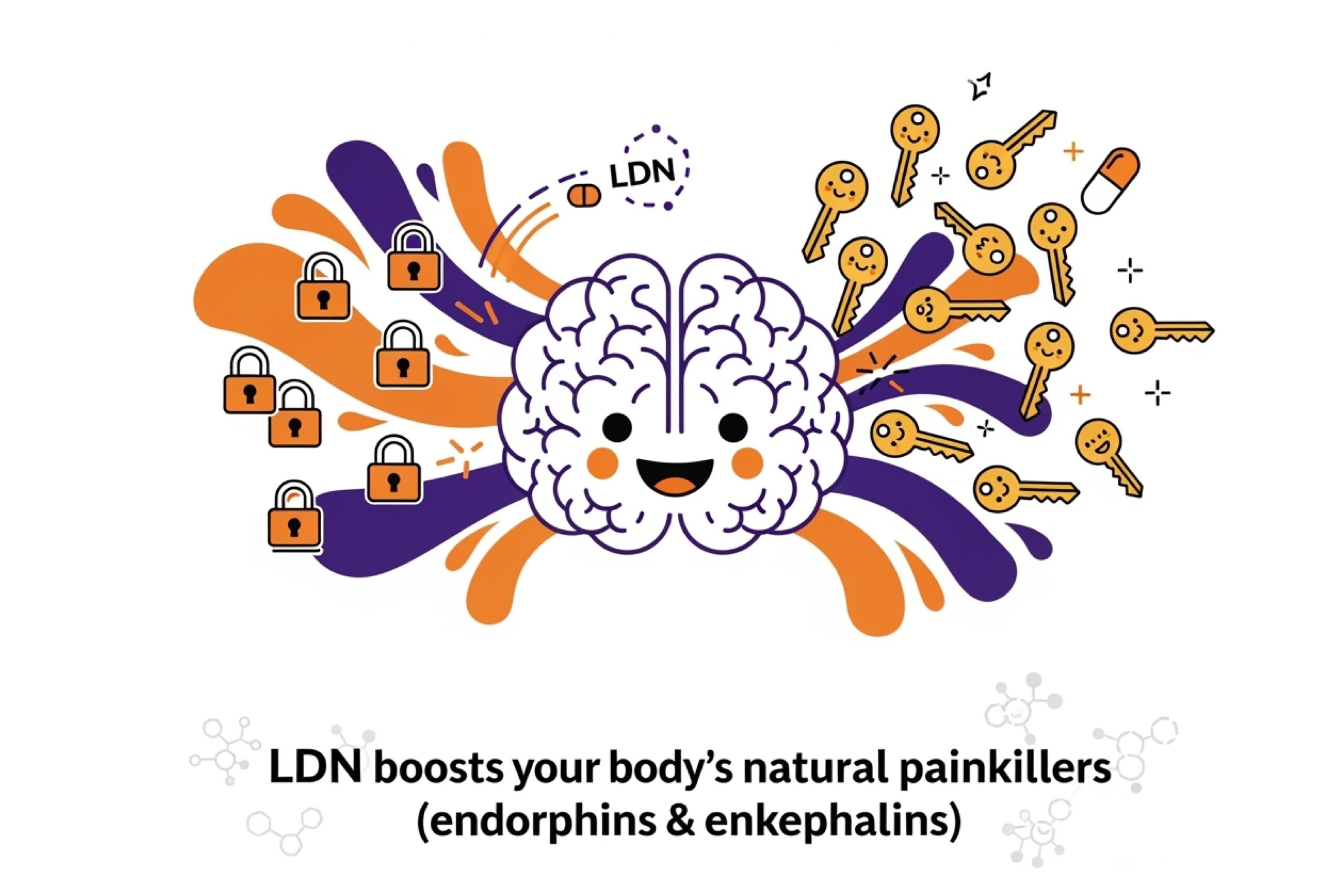
Finding the correct dose of naltrexone
Dr. Bihari and his team first tried naltrexone at full strength (50mg), which did increase endorphin levels, but also blocked their effects so that the body couldn’t use the extra endorphins.
They realised the goal was to boost endorphins without blocking them.
Through careful testing, they found that a much lower dose—between 1.75 mg and 4.5 mg—was sufficient to trigger the body to produce more endorphins, while not blocking their positive effects [3]. This is the dose range now known as “low-dose naltrexone” or LDN [3].

The role of endorphins and opioid receptors
We have discussed the endorphins and the enkephalins, but an article on LDN would not be complete if we did not mention the opioid receptors.
How receptors work
Before we do that, let’s discuss how these natural and synthetic opioids interact with their corresponding receptors.
Think of opioid receptors as locks on the doors of nerve cells, and opioids (like endorphins, enkephalins, or pain medicines) as keys. When the correct key fits into the lock, the door closes, blocking pain signals, so you feel less pain and sometimes experience a boost of positive feelings.
Now, imagine naltrexone as a “dummy key” or a blocker that fits into the lock but doesn’t turn it.
When naltrexone is in the lock, it blocks the genuine keys (your natural opioids or pain medicines) from getting in. This means the door stays open, allowing pain signals to pass through.
However, when naltrexone is used in very low doses (low-dose naltrexone or LDN), it only blocks the locks for a short time.
Your body notices this and responds by making more of its own natural keys (endorphins and enkephalins) to overcome the block.
Once the blocker (naltrexone) leaves, those extra natural keys can get to the locks, helping to boost your body’s natural pain relief and feel-good effects even more.

In summary:
Opioids are like keys that lock pain out. Naltrexone is a blocker key that keeps other keys out for a while. In low doses, this trick actually encourages your body to produce more of its own natural pain-blocking compounds, which can help alleviate pain and improve well-being once the blocker is gone.

Opioid receptors
There are different types of opioid receptors in the body:
- Mu opioid receptors are found in the brain. Beta-endorphins and morphine bind strongly to them. These receptors are primarily associated with pain relief in the brain [15].
- Delta opioid receptors are found throughout the body and spinal cord and are involved in pain relief, and in addition, help with mood [21]. Met-enkephalin or opioid growth factor binds most strongly to this type of opioid receptor [15].

The zeta opioid receptor or Opioid Growth Factor Receptor (OGFr)
In the 1980s, scientists discovered another type of opioid receptor, first called the zeta receptor. Later, it was renamed the opioid growth factor receptor (OGFr) because it helps regulate cell growth [22]. The natural chemical that interacts with this receptor, met-enkephalin, is sometimes referred to as opioid growth factor (OGF) [22].
OGFr is found in many parts of the body, including the brain, heart, liver, and muscles. It sits on the edge of a cell’s nucleus (the cell’s control centre) and moves inside when it binds to OGF.
This helps regulate cell growth and renewal, not just in healthy cells, but also in cancer cells. Because of this, scientists believe the OGF-OGFr system may play a crucial role in development, cancer prevention, and maintaining cell health [22].

Why this matters for cancer and immunity
Research has shown that people with cancer often have very low endorphin levels—sometimes less than a third of what’s normal [3]. This means their bodies are missing a key natural defence against cancer.
Animal studies have shown that when mice with cancer are given opioid growth factor or met-enkephalin, many of them don’t get cancer at all, or their tumours grow much more slowly [23].

Summary of Ian Zagon’s study on the role of opioid growth factor in cancer
This study examined a natural body chemical called opioid growth factor (OGF), also known as met-enkephalin, and its specific receptor, the OGF receptor (OGFr) [23].
The researchers wanted to see how this OGF-OGFr system affects the growth of cancer cells.

What did they find?
The findings of the study are summarised below [23]:
- OGF and its receptor are found in many types of human cancer cells.
- OGF acts like a natural “brake” that slows down the growth and division of these cells.
- When more OGF was added to cancer cells in the lab, the cells grew more slowly.
- When the OGF system was blocked (either with a drug like naltrexone or by stopping the receptor from working), the cancer cells grew faster.
- This slowing down of cell growth is not harmful to the cells and doesn’t kill them—it simply helps keep their growth in check.
- The OGF-OGFr system is present in over 90% of the main types of human cancers tested.
- This means our bodies have a built-in system that can help control cancer cell growth.
Your body produces a natural chemical (OGF) that can slow the growth of many types of cancer cells, working through a specific receptor (OGFr).
Enhancing this system or replicating its approach may lead to new, safer methods for treating cancer in the future.
A quick and simple way to increase the OGF-OGFr system is to use LDN’s ability to trick the brain into producing more enkephalins to overcome the temporary block of the opioid receptors.

More science: How does LDN work in the body?
LDN and the “hormetic principle”
Most medicines work in a straight line—the higher the dose, the stronger the effect.
LDN is different. It follows what scientists call the “hormetic principle,” where low doses can have effects that are not only weaker but fundamentally different from those of high doses [24]. In other words, LDN’s low dose unlocks a whole new way of working in the body.

Chirality: Why the shape of LDN matters
Here’s where it gets really interesting—and a bit “sciencey,” but don’t worry, we’ll keep it simple. Many medicines, including naltrexone, come in two mirror-image forms, called enantiomers, which are non-superimposable [25]. This phenomenon is referred to as chirality [25].
Think of your left and right hands: they’re mirror images, but you can’t perfectly fit a left glove on your right hand. In chemistry, these “handed” molecules are called levo (left) and dextro (right) isomers.
Naltrexone, when made for human use, is a 50:50 mix of both levo (left) and dextro (right) forms. Most drugs have their main biological activity in the levo (L) form—levothyroxine (the active form of thyroid hormone) is a good example.
Before examining the effects of different naltrexone forms, we will briefly discuss microglia.

What are microglia?
We have already mentioned that LDN can decrease inflammation, but how does it do so?
Microglia are special immune cells (macrophages) in your brain and spinal cord [26].
Think of them as the brain’s own “clean-up crew.” They fight off infections, clean up damage, and help keep your brain healthy. However, if microglia remain activated for too long, they can cause ongoing inflammation, leading to issues such as pain, fatigue, and brain fog.

How does low-dose naltrexone (LDN) reduce inflammation?
Naltrexone at higher strengths is used for opioid addiction because it blocks opioid receptors in the body. However, in smaller doses, though, naltrexone does something extra: it helps calm down inflammation, especially in the brain.
LDN works in two main ways:
- Blocking opioid receptors: At regular (higher) doses, naltrexone blocks opioid receptors, which are involved in pain relief and pleasure. This is why it’s used for addiction.
- Calming microglia: More importantly for inflammation, LDN blocks a different kind of receptor called Toll-like receptor 4 (TLR4) on microglia [27]. When microglia are overactive, they release chemicals that cause pain and tiredness. By calming these cells, LDN helps reduce inflammation and protect nerve cells.

Which naltrexone isomer does what?
Naltrexone comes in two forms, or “isomers,” called levo-naltrexone and dextro-naltrexone.
- Levo-naltrexone is the form that blocks opioid and endorphin receptors. This is the part responsible for the classic effects of naltrexone—blocking opioid drugs, but also triggering the body to make more endorphins when used at a low dose [3]. This upregulation of endorphins is linked to immune system modulation and even a reduction in abnormal cell growth (cell proliferation) via endorphins.
- Dextro-naltrexone acts differently. It doesn’t block opioid receptors, but it does block certain parts of the immune system, specifically Toll-like receptors (TLRs), particularly TLR4 [27] on immune cells. By antagonising (blocking) these TLRs, dextro-naltrexone can help suppress the overactive, cytokine-driven immune response, reduce inflammation, and even lower the activity of NF-kB—a key player in inflammation and cancer gene activation (oncogenes [28].
So, while both isomers can help reduce inflammation, only levo-naltrexone works on opioid receptors, and only dextro-naltrexone targets microglia without blocking opioid effects.
So, when you take naltrexone, you’re getting both forms:
- The levo part boosts endorphins and helps regulate the immune system.
- The dextro part calms inflammation by blocking TLRs and the production of inflammatory molecules.

Imagine LDN as a key that fits two different locks—one for pain and mood (the levo side), and one for inflammation (the dextro side). That’s why LDN can have such a wide range of effects in the body.

Summary: How does low-dose naltrexone (LDN) work?
Low-dose naltrexone is a tiny dose of a medicine originally used to treat addiction, naltrexone. But it’s now being explored for a wide range of health problems, like autoimmune diseases, chronic pain, gut issues, and even cancer.
How can one small pill help with so many things? Let’s break it down.
How LDN works in the body
- LDN briefly blocks opioid receptors. Think of these as “locks” on your nerve cells. Normally, your body’s natural painkillers (endorphins and enkephalins) are the “keys” that fit these locks to block pain and boost mood.
- When you take LDN at night, it temporarily blocks these locks. The body notices and responds by making more of its own painkillers—so when LDN wears off, you have extra endorphins and enkephalins ready to help with pain, mood, and immune balance.
- LDN also calms inflammation. It achieves this by blocking TL4 receptors on specialised immune cells in the brain, known as microglia. When microglia become overactive, they trigger inflammation, pain, and a condition known as “brain fog.” LDN helps settle them down, lowering inflammation throughout the body.
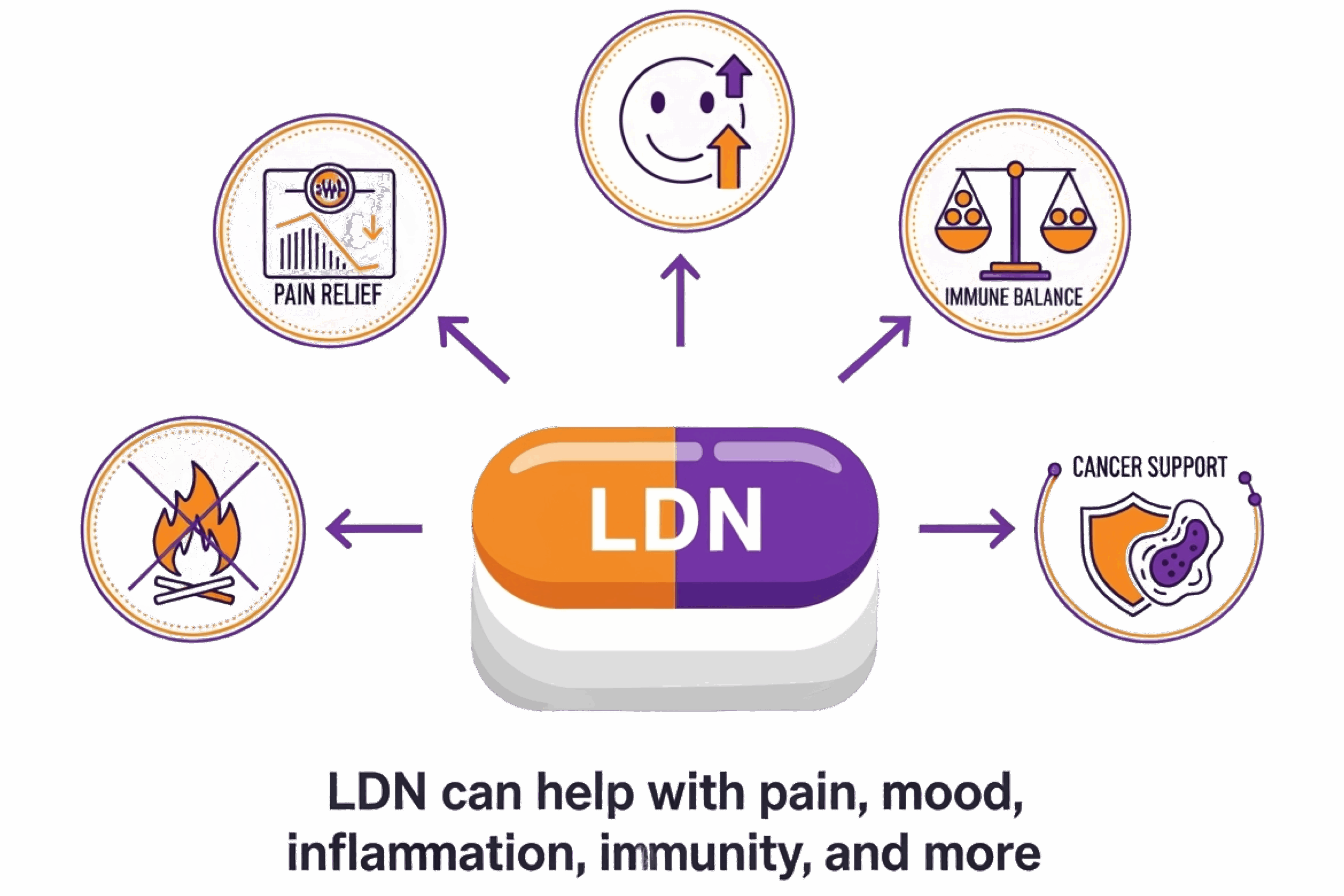

Why is LDN called “pleiotropic”?
- “Pleiotropic” is just a fancy word that means “having many different effects.” LDN isn’t a one-trick pony—it can help with pain, mood, inflammation, immune balance, and possibly even slow cancer cell growth.
- This wide range of benefits is why LDN is being studied for so many health problems.

How is LDN able to do so many different things? (Chirality explained)
LDN’s secret is its chiral nature—it comes in two mirror-image forms (like your left and right hands). These are called “isomers.”
- Levo-naltrexone (the “left-handed” form) blocks opioid receptors. This triggers the body to produce more endorphins, which help alleviate pain, improve mood, and enhance immune function.
- Dextro-naltrexone (the “right-handed” form) doesn’t affect opioid receptors, but it blocks inflammation by calming microglia by blocking special immune sensors called TLR4.
Because both forms are present in the medicine, LDN can boost your natural painkillers and lower inflammation at the same time. That’s why it’s called pleiotropic—it works in different ways, in other parts of the body.

Tips for using LDN
- Start low, go slow: Begin with a low dose (like 0.5mg or 1mg) and increase gradually as your doctor recommends.
- Track your symptoms: Keep a diary to see how you feel over time.
- Be patient: It can take at least three weeks to see full benefits.
- Always use a proper compounding pharmacy: Get your LDN from a registered compounding pharmacy, like Courier Pharmacy.
- Start with the compounded LDN 1mg/ml oral liquid first to help you find the correct maintenance dose. The liquid facilitates easier titration or dose adjustments. Then, once the maintenance dose is reached, you can switch over to the LDN capsules.
- Alternatively, you can try the compounded LDN capsules starter pack, which contains a range of LDN capsules in different strengths, ranging from 0.5mg to 4.5mg.
LDN FAQs
Is LDN addictive?
No, LDN is not addictive and doesn’t cause withdrawal.
Can I take LDN with other medicines?
A: Usually yes, but not with opioid painkillers. Always check with your doctor.
How long does it take to work?
Some people feel better within a few weeks, while for others, it may take a couple of months.
Why isn’t LDN licensed for more conditions?
Most uses are considered “off-label” because large-scale studies are still being conducted. Early results are promising, but more evidence is needed.
Where can I purchase LDN (low-dose naltrexone) in the UK?
You can buy LDN from courierpharmacy.co.uk after completing the LDN consultation.

Courier Pharmacy is your trusted specialist for Low Dose Naltrexone (LDN) compounding.
With years of experience, our expert team can prepare LDN in various forms—including oral liquids, capsules, and rapid-dissolving buccal films—to suit your needs. Can’t find the exact strength or dosage form you’re after? Just get in touch—our compounding pharmacist will work with you to create a bespoke solution.

Why choose Courier Pharmacy for your LDN?
- FREE private LDN prescriptions
- FREE LDN consultations
- Wide range of LDN preparations
- Affordable, high-quality compounded LDN options
If you need a personalised approach or have special requirements, contact us today and let us help you find the perfect LDN solution.
This information is for general guidance only. For medical advice, please consult your doctor or healthcare provider.

References
- NICE (2025) Naltrexone hydrochloride: Indications and dose. British National Formulary. Available at: https://bnf.nice.org.uk/drugs/naltrexone-hydrochloride/#indications-and-dose (Accessed: 24 July 2025).
- Drugs.com (2025) Naltrexone. Available at: https://www.drugs.com/naltrexone.html (Accessed: 24 July 2025).
- Bihari, B. (2013) ‘Low-dose naltrexone for normalising immune system function’, Alternative Therapies in Health and Medicine, 19(2), pp. 56–65. Available at: https://todayspractitioner.com/wp-content/uploads/2013/10/Bernard-Bihari-MD-Low-dose-Naltrexone-for-Normalizing-Immune-System-Function-athm_19_2_bihari_56_65.pdf (Accessed: 24 July 2025).
- Zagon, I.S. and McLaughlin, P.J., 1983. Naltrexone modulates tumor response in mice with neuroblastoma. Science, 221(4611), pp.671-673.
- Toljan, K. and Vrooman, B., 2018. Low-dose naltrexone (LDN)—review of therapeutic utilization. Medical Sciences, 6(4), p.82.
- Blalock, J.E. and Smith, E.M., 1985, January. A complete regulatory loop between the immune and neuroendocrine systems. In Federation Proceedings (Vol. 44, No. 1 Pt 1, pp. 108-111).
- Plein, L.M. and Rittner, H.L., 2018. Opioids and the immune system–friend or foe. British journal of pharmacology, 175(14), pp.2717-2725.
- Boué, J., Blanpied, C., Djata-Cabral, M., Pelletier, L., Vergnolle, N. and Dietrich, G., 2012. Immune conditions associated with CD4+ T effector-induced opioid release and analgesia. Pain, 153(2), pp.485-493.
- Sauer, R.S., Hackel, D., Morschel, L., Sahlbach, H., Wang, Y., Mousa, S.A., Roewer, N., Brack, A. and Rittner, H.L., 2014. Toll like receptor (TLR)-4 as a regulator of peripheral endogenous opioid-mediated analgesia in inflammation. Molecular pain, 10, pp.1744-8069.
- Mousa, S.A., Shakibaei, M., Sitte, N., Schäfer, M. and Stein, C., 2004. Subcellular pathways of ?-endorphin synthesis, processing, and release from immunocytes in inflammatory pain. Endocrinology, 145(3), pp.1331-1341.
- Jain, A., Mishra, A., Shakkarpude, J. and Lakhani, P., 2019. Beta endorphins: the natural opioids. Ijcs, 7(3), pp.323-332.
- Simantov, R. and Snyder, S.H., 1976. Morphine-like peptides in mammalian brain: isolation, structure elucidation, and interactions with the opiate receptor. Proceedings of the National Academy of Sciences, 73(7), pp.2515-2519.
- Harno, E., Gali Ramamoorthy, T., Coll, A.P. and White, A., 2018. POMC: the physiological power of hormone processing. Physiological reviews, 98(4), pp.2381-2430.
- García-Domínguez M. Enkephalins and Pain Modulation: Mechanisms of Action and Therapeutic Perspectives. Biomolecules. 2024 Jul 30;14(8):926.
- Koneru, A., Satyanarayana, S. and Rizwan, S., 2009. Endogenous opioids: their physiological role and receptors. Global J Pharmacol, 3(3), pp.149-153.
- Hughes, J.T.H.L.B.H., Smith, T.W., Kosterlitz, H.W., Fothergill, L.A., Morgan, B.A. and Morris, H.R., 1975. Identification of two related pentapeptides from the brain with potent opiate agonist activity. Nature, 258(5536), pp.577-579.
- Comb, M., Seeburg, P.H., Adelman, J., Eiden, L. and Herbert, E., 1982. Primary structure of the human Met-and Leu-enkephalin precursor and its mRNA. Nature, 295(5851), pp.663-666.
- Bastiaensen, E. and De Potter, W., 1987. Enkephalin containing peptides in the peripheral sympathetic nervous system. Neurochemistry international, 11(3), pp.313-321.
- Livett, B.G., Dean, D.M., Whelan, L.G., Udenfriend, S. and Rossier, J., 1981. Co-release of enkephalin and catecholamines from cultured adrenal chromaffin cells. Nature, 289(5795), pp.317-319.
- Smith, J.P., Bingaman, S.I., Mauger, D.T., Harvey, H.H., Demers, L.M. and Zagon, I.S., 2010. Opioid growth factor improves clinical benefit and survival in patients with advanced pancreatic cancer. Open access journal of clinical trials, pp.37-48.
- Pradhan AA, Befort K, Nozaki C, Gavériaux-Ruff C, Kieffer BL. The delta opioid receptor: an evolving target for the treatment of brain disorders. Trends Pharmacol Sci. 2011 Oct;32(10):581-90.
- Wang, R., Zhang, Y. and Shan, F., 2019. Interaction of opioid growth factor (OGF) and opioid antagonist and their significance in cancer therapy. International Immunopharmacology, 75, p.105785.
- Zagon, I.S., Hytrek, S.D., Lang, C.M., Smith, J.P., Mcgarrity, T.J., Wu, Y. and Mclaughlin, P.J., 1996. Opioid growth factor ([Met5] enkephalin) prevents the incidence and retards the growth of human colon cancer. American Journal of Physiology-Regulatory, Integrative and Comparative Physiology, 271(3), pp.R780-R786.
- Calabrese EJ. Hormesis: a fundamental concept in biology. Microb Cell. 2014 Apr 23;1(5):145-149.
- Prelog, V., 1976. Chirality in chemistry. Science, 193(4247), pp.17-24.
- Kettenmann, H., Hanisch, U.K., Noda, M. and Verkhratsky, A., 2011. Physiology of microglia. Physiological reviews, 91(2), pp.461-553.
- Wang, X., Zhang, Y., Peng, Y., Hutchinson, M.R., Rice, K.C., Yin, H. and Watkins, L.R., 2016. Pharmacological characterization of the opioid inactive isomers (+)?naltrexone and (+)?naloxone as antagonists of toll?like receptor 4. British journal of pharmacology, 173(5), pp.856-869.Zagon, I.S. and McLaughlin, P.J. (1983) ‘Naltrexone modulates tumour response in mice with neuroblastoma’, Science, 221(4611), pp. 671–673.
- Liu, W.M. and Dalgleish, A.G., 2022. Naltrexone at low doses (LDN) and its relevance to cancer therapy. Expert review of anticancer therapy, 22(3), pp.269-274.
